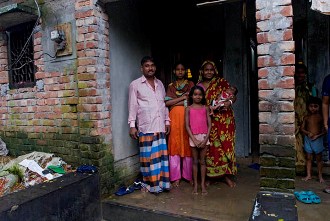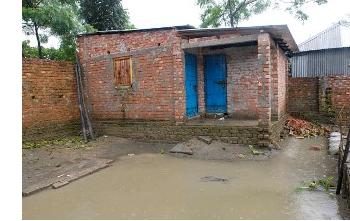DHAKA, 17th August 2007: Nine Habitat for Humanity families in the village of Pora Bari, in Savar, about 35 kilometers from the capital Dhaka, have been left stranded since flood waters inundated their community earlier in the month.
 But the strength of a properly-made home was evident for home owner Nilu Rami, 30, her husband Nikhil Chandra, 36, and their children. Their Habitat house built on raised solid stone and concrete foundations fared better than the homes of their neighbors which were directly on the ground.
But the strength of a properly-made home was evident for home owner Nilu Rami, 30, her husband Nikhil Chandra, 36, and their children. Their Habitat house built on raised solid stone and concrete foundations fared better than the homes of their neighbors which were directly on the ground.
"The flooding this year has been very serious, especially last week when the water was well over a meter high," said Nilu. "We were lucky since we live on a higher level, but others in the community had a difficult time as their homes were under water."
"For nearly ten days, it was difficult because of the high water levels. We survived on what we could, mainly rice and potatoes."
The family is getting back on its feet as the waters recede. But for well over a week husband Nikhil could not make his daily trip to Dhaka buy the fish he needs to sell in the main market in Savar.
However, the inundation has not deterred Nilu from her responsibilities. This week she still made her 500-taka monthly repayment on her mortgage loan, the equivalent of about US$7.30.
Looking ahead the focus is on how to rebuild for the longer term. Habitat for Humanity's Asia-Pacific appropriate technology manager Fernando Morales Torres indicated that in low-lying communities that are susceptible to flooding on a regular basis, such as Pora Bari, one solution would be building on cement pillars that are higher than regular flood water levels.
 During a visit to the village with other members of the assessment team from Habitat for Humanity International and HFH Bangladesh, he said: "I saw the majority of houses built using a traditional mud design. If their metal roofs came out further, these houses would be covered properly during the rainy season; they would be even better protected if raised off the ground."
During a visit to the village with other members of the assessment team from Habitat for Humanity International and HFH Bangladesh, he said: "I saw the majority of houses built using a traditional mud design. If their metal roofs came out further, these houses would be covered properly during the rainy season; they would be even better protected if raised off the ground."
"Other construction methods which would work here would be using a combination of mud, cement and straw to produce adobe bricks. We are also looking into a design using woven bamboo with cement plastered over to produce a solid wall."
"If we can build a higher design house, it would lessen the effects the families will encounter in future flood conditions," Torres added.
HFH Bangladesh has built six homes in the village with three more under construction. Working with partner World Vision in a microfinance savings scheme, 21 local families are slated to become future home partners.
HFH Bangladesh has built and rehabilitated approximately 1,000 homes. It operates mainly through Habitat Resource Centers and related satellite centers in local communities. Many projects are under taken in partnership with other non-governmental organizations.
Nearly 10,250,000 people in 39 districts throughout Bangladesh are now reported to have been affected by the recent flooding, making it the worst monsoon in ten years.
Assessing the Affects of Devastating Flooding – and Rebuilding Options – on Habitat Homes in a Bangladeshi Village
2007/08/29
